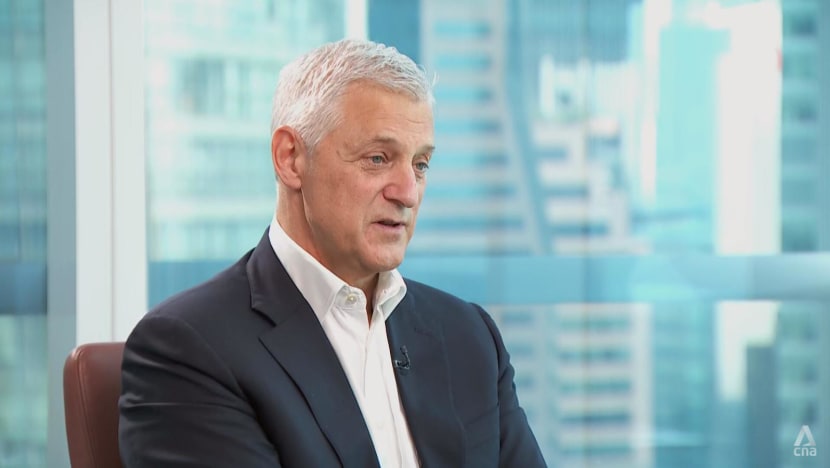Tech evolution will mean more job displacement at Standard Chartered, but staff will be reskilled: CEO
In an exclusive interview with CNA, Standard Chartered CEO Bill Winters spoke about issues such as the impact of technology on jobs, interest rates, its losses in China, and Dubai’s growing status as a global financial hub.

Standard Chartered CEO Bill Winters spoke to CNA in an exclusive interview.

This audio is generated by an AI tool.
SINGAPORE: Some jobs at Standard Chartered – especially in more manual areas such as technology and operations – will “go away” as the Asia-focused lender continues to cut costs and automate its processes, the bank’s CEO Bill Winters told CNA on Thursday (Apr 4).
However, he stressed that affected employees will be given the option to take up other roles within StanChart, and that its headcount in Singapore has been “stable”.
“(Our) transformation is about investing in technology to continually improve our business, and hopefully producing better outcomes for clients,” he added.
“People will absolutely be displaced, but we’re being thoughtful about it and doing everything we can to retrain and reskill along the way.”
Mr Winters, who has helmed the British lender for nearly nine years, was speaking to CNA in a wide-ranging interview on topics including layoffs, its hefty losses in China, forecasts for interest rate cuts by the US Federal Reserve, and Dubai becoming StanChart’s third-biggest market after Singapore and Hong Kong.
StanChart earns most of its profits in Asia, Africa and the Middle East.
LAYOFFS
In June last year, Bloomberg News reported that StanChart was starting to lay off employees across Singapore, Hong Kong and London as part of an existing plan to slash costs by more than US$1 billion from 2022 to 2024.
According to Bloomberg, the bank trimmed roles in middle-office functions, including human resources and digital transformation in Asia. A StanChart spokesperson said it was “part of normal business activity” to review its role requirements on an ongoing basis across the bank.
On Thursday, when asked if job roles at StanChart would need to transform given the bank’s investment in technology, Mr Winters answered: “Yeah, for sure.”
He noted how the nature of banks has evolved in the 40 years that he has been in the industry, with people being displaced and new jobs being created.
Despite this, he said headcount at StanChart has remained “more or less the same” from when he joined the bank in 2015.
Voluntary attrition has stood at between 9 and 11 per cent per year, while performance-related attrition is at 1 or 2 per cent per year. Jobs lost at the bank stand at “probably 3 to 4 per cent” annually.
“That’s not because it’s the target. It’s because we’ve been investing at the same time that we’ve been contracting in other things. That’s the nature of our business, and will continue to be,” Mr Winters said.
“Will people be displaced? Yes.”
Addressing questions on how the job cuts have affected morale and operations, and where the layoffs came from, Mr Winters said that StanChart’s transformation programme was not about cost-cutting or job-cutting.
“We will take expenses out, but it’s going to be by simplifying our business by digitising everything that we do, and by automating everything that we do.
“So over periods of time, in particular in the technology and operations areas, there will be jobs that go away, then we can have lots of people who are doing manual tasks today that will be done by machines in the future,” Mr Winters added.
This will not happen overnight, he said, giving an example of replacing a loan processing system in Bangalore that will cut 20 jobs. The bank and staff will know this is happening “probably a year ahead of time”.
He said: “We’re reskilling them, we’re training them. We’re giving them every opportunity, especially in service centres – we have large service centres in Kuala Lumpur, Bangalore, Chennai.”
CYBERSECURITY CONCERNS
CNA had also spoken to someone who was recently laid off from StanChart’s Singapore unit and said there was a “noticeable decrease” in the bank’s cybersecurity teams.
When asked how the bank ensures the cybersecurity aspect of its business remains robust even as jobs are cut, Mr Winters responded: “I can't relate that to our business. We've only increased our spending on cybersecurity.
“We've vastly improved our protection, so they started in a good place. They're now, I would say, in an excellent place.”
He added that the bank is “extremely cautious” about cybersecurity and will continue this.
Mr Winters also spoke about how far a US$1 billion buyback scheme, announced in February, could go in boosting StanChart’s stock. He had vowed to fix it at the time while telling reporters that the share price was “crap”.
Mr Winters said on Thursday: “I think probably what I meant was that our share price was fertiliser that can promote growth and prosperity and drive commerce. I’m sure that’s what I meant at the time, but I probably also meant that our share price doesn’t reflect the value that we see in the bank.”
LOSSES IN CHINA
Meanwhile, China’s economic challenges have hit StanChart hard, with Mr Winters saying he does not think the property crisis in the world’s second-largest economy will go away anytime soon.
The bank took a US$850 million impairment from its investment in Chinese lender Bohai Bank due to the downturn in the Chinese real estate market. It also took another US$282 million provision on expected loan losses relating to the ailing sector.
Reuters reported that this has stymied StanChart’s efforts to regain investor confidence.
Mr Winters described the bank’s impairment in China as “quite painful” but “not outsized at all”.
He added: “I think we’ll have a tense few years where China has established an extremely vibrant new economy segment, which may meet resistance internationally, at the same time as it got extremely negative sentiment.
“So I think China’s got a few tough years, but it’s structurally in extremely good shape.”
Despite absorbing the China real estate losses, Mr Winters noted that StanChart has almost doubled profits.
He added that both the Dubai and Singapore markets are “extremely frothy”, given their popularity among wealthy people who want to live there.
With an “enormous inflow of talent” in Dubai and its growth as a financial hub in the Middle East, Mr Winters said he is “very optimistic” about the city.
“Interestingly for us, our third biggest sort of hub, market, is the UAE (United Arab Emirates), Dubai and Abu Dhabi, and it wasn’t always that way,” he added.
He had previously said during the World Government Summit, held in Dubai in February, that the UAE is now one of the top three global financial hubs alongside Hong Kong and Singapore.
“We have the great privilege of being very strong in all three markets and all three are growing extremely well for us, serving very different subsets of the world,” Mr Winters noted.
When asked if Singapore has surpassed Hong Kong, Mr Winters said both have distinct roles. Hong Kong has long since been established as the gateway to China, while Singapore has an “extremely important” and different relationship with China and serves as the financial hub in Southeast Asia, he added.
“FASCINATING” POINT OF ECONOMIC, MARKET INFLATION
Mr Winters then turned to the US Federal Reserve’s interest rate policy, saying he thinks rates will be “a little bit higher for a little bit longer” given the current strong state of the US economy.
“We’re in a fascinating point of economic and market transition. There really isn't a strong consensus about – not whether rates will come down. Rates will come down. I mean, inflation has clearly dropped a lot,” he said.
“I think with a strong US economy and a lower but still stubbornly above-target inflation, the Fed is going to be a little bit slower than the market is expecting.”
Over the past week, StanChart said on its website that it would lower the maximum interest rate on its Bonus$aver account to 7.68 per cent per annum from May 1. This is down slightly from 7.88 per cent – the highest offered by the savings account – when the bank last hiked its interest rates in January last year.
“CRIMINALS DON’T COME TO US”
When asked what this means for the bank’s digital assets, including cryptocurrency, Mr Winters said there is a “much more interesting role” in the world for a digital assets marketplace.
He added: “When it comes to creating a digital form of US dollars or Singapore dollars or Singapore government bonds, which has led to a pilot transaction to tokenise Singapore government bonds and sell those to fixed income investors – that's very exciting.
“To me, I can see the entire financial infrastructure shifting from the current form of securities and mutual funds and things like that, to different types of tokens.”
This means that someone can make an immediate payment between StanChart and DBS accounts, for instance, and it will be recognised in five seconds, Mr Winters said.
“There’s a big difference between having to go through five intermediaries and having one single blockchain that is adjusted, and the buyer and the seller both recognise with 100 per cent certainty that no, you can't corrupt these blockchains.
“(It) eliminates the fraud, significantly improves the ability for law enforcement to check compliance because you can check every node on these blockchains. So the market will go that way. We will be at the lead of that as a bank.”
Mr Winters said people are “flooding” into StanChart’s cryptocurrency ventures, highlighting the bank’s “unquestioned” compliance.
"The criminals don't come to us because they're not going to get an account," he added.
“But people who are using these things for the right reasons, they're coming to institutional players like us, and they're leaving the places that were a little bit Wild West, and that's the way markets evolve.”


















